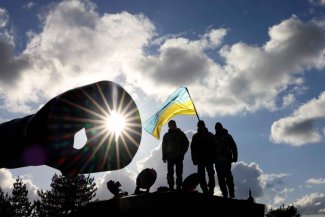The offensive along the Zaporizhzhia front slows down. Day 477 of the war

Over the past few days there has been a marked reduction in the intensity of fighting compared to last week. The Ukrainians are continuing to carry out reconnaissance operations along the section of the front near Orikhiv, and have not made any attempts to storm the enemy positions. At Velyka Novosilka, their advance along the main axis was stopped between Makarivka and Staromayorske, about 7 km from the front line as it stood before 4 June. The Russians (here including elements of the 127th Motorised Rifle Division, the 37th and 60th Motorised Rifle Brigades and the 5th Tank Brigade) counterattacked from their starting base along the Pryyutne-Staromayorske-Kermenchyk line, but failed to retake the areas they had lost earlier. According to the available information, both sides have so far been operating in the area in company- and battalion-size units, without committing whole brigades to the battle.
At Bakhmut, the Ukrainians are carrying out offensive operations on a limited scale, mainly to capture Klishchiivka, Berkhivka and Jahidne. Here too they have been using a relatively small part of their grouping in combat, not resorting to their reserves. The attacks have the character of a slow push through the enemy’s defensive lines (any progress is counted in hundreds of metres per day at best), and are being carried out by troops who have been present in these areas for a long time. Along the rest of the front, local clashes are taking place: these are not significantly changing the two sides’ position, and they do not indicate the commitment of their operational reserves.
The Russians continued to attack targets deep inside Ukraine using Shahed-131/136 kamikaze drones and missiles. On the night of 13–14 June, they used 10 drones, four Kalibr missiles and six Kh-22 cruise missiles. According to the Ukrainian Air Force Command, nine drones and three Kalibr missiles were shot down, with one hitting facilities in Odesa. In addition, Kh-22 missiles fell on Kostiantynivka and Kramatorsk. The military losses in these places are unknown, although the Ukrainian side has published photographs showing the destruction of civilian facilities and the deaths of several people. On the other hand, during the night of 14–15 June, the invaders used 20 drones and five Kh-101/Kh-555 and Kh-59 missiles; Ukraine’s air defence stated that it had neutralised all the drones and one of the missiles. However, the other four hit industrial facilities located in the area of Kryvyi Rih. On 16 June, the Russians launched a massive missile attack on Kyiv before midday. According to the first reports from the Ukrainian side, their anti-aircraft defence shot down six Kindzhal aerial missiles and six Kalibr cruise missiles.
On 13 June, the Pentagon announced a new military support package for Ukraine. It is worth $325 million, and includes additional missiles for NASAMS & Stinger anti-aircraft systems and HIMARS launchers, 155-mm and 105-mm artillery ammunition, Javelin and TOW anti-tank guided missiles, AT-4 grenade launchers and 22 million rounds of small arms ammunition and grenades. In addition, the US decided to send another 15 M2A2 ODS Bradley infantry fighting vehicles and 10 Stryker wheeled armoured personnel carriers to supplement the vehicles the Ukrainians lost in the early days of the offensive. On the same day, during a meeting of the Joint Expeditionary Force’s defence ministers, the UK, Norway, the Netherlands, Denmark, Sweden, Iceland and Lithuania announced they would contribute a further $117 million to the International Fund for Ukraine (IFU), the aim being to purchase radars and air defence missiles for Kyiv.
On 14 June, the Netherlands announced that it would acquire four VERA-NG passive radar systems worth €150 million for Ukraine in the Czech Republic. Meanwhile, Denmark’s acting defence minister Troels Lund Poulsen announced that the training of Ukrainian pilots on F-16s in his country may not start until August; before that, legislative changes must be made and logistical facilities prepared. He also said that the Ukrainians would need to improve their English-language skills.
A day later, the 13th meeting of the Ukraine Defence Contact Group in the Ramstein Air Base was held. Summarising it, US Secretary of Defence Lloyd Austin called on all countries to step up deliveries. Immediately prior to the event, Norway and Denmark announced a joint transfer to Kyiv of 9000 155-mm artillery shells (the fuses are given by Denmark). In addition, Norway stated that it was in the process of delivering a further 7000 155-mm artillery shells on its own. During the meeting, the US, the UK, the Netherlands and Denmark reported that they had jointly purchased a significant number of air defence missiles for post-Soviet systems on the secondary market; the deliveries are already underway, and are expected to be completed within weeks. No more details were disclosed. In addition, the Netherlands, Denmark, Spain and Canada reiterated their earlier announcements of further supplies, which they had been making since the second half of April.
On 16 June, Germany announced that it would immediately transfer another 64 missiles for the Patriot medium-range air defence system to Ukraine. On the same day, Rheinmetall’s CEO Armin Papperger declared that his company would send Kyiv between 40,000 and 60,000 35-mm ammunition rounds for the Gepard self-propelled anti-aircraft guns this year. Furthermore, Germany has announced it has delivered two more WISENT 1 mine clearing tanks to Ukraine..
A day earlier, the European Parliament adopted a resolution calling on NATO members to honour their commitments to Ukraine and pave the way for inviting it to join the alliance. It stressed that “the accession process will start after the end of the war and will be finalised as soon as possible”, and that the country’s integration into both NATO and the EU would enhance regional and global security and strengthen the ties between it and the Euro-Atlantic community. The parliament reaffirmed its support for last year’s European Council decision to grant Ukraine EU candidate status. It hoped for a positive recommendation from the European Commission on Kyiv’s fulfilment of the pre-accession conditions. This will allow accession negotiations to begin later this year.
On 13 June, Vladimir Putin met a select group of military journalists. He acknowledged that the large-scale Ukrainian counter-offensive had begun on 4 June. He referred for the first time to the attacks on the Belgorod oblast, which he painted as an attempt to draw some Russian forces away from the frontline. He insisted that the defences of the border was being strengthened, but threatened that a ‘cordon sanitaire’ would be established in Ukraine if Russian territory continued to come under attack. He added that there was no need to impose martial law or declare general mobilisation. According to Putin, the Russian army has recruited more than 150,000 contract soldiers and 156,000 volunteers since January this year. The president also addressed the legal status of the so-called private military companies (PMCs): he announced that he had asked the State Duma and the defence ministry to prepare regulations to define the rules of interaction between the PMCs and the regular army. He confirmed that the only way to receive social guarantees from the state (such as the payment of compensation to the family in the event of the death of a ‘volunteer’) will be to sign a contract with the armed forces. On 14 June Yevgeny Prigozhin, the owner of the Wagner Group private military company, who has repeatedly come into conflict with the defence ministry, once again rejected the possibility of signing a contract with the army. He expressed the hope that the authorities would find a compromise solution to give veteran rights to the ‘volunteers’ under his control.
Also on 13 June, Chechen leader Ramzan Kadyrov announced that the ‘Akhmat-West’ battalion under his control would be deployed to Russia’s border regions to repel attacks by Ukrainian sabotage groups. Kadyrov’s colleague and State Duma deputy Adam Delimkhanov met the governor of the Belgorod oblast, Vyacheslav Gladkov, as well as representatives of the Russian defence ministry and the National Guard. It was emphasised that the Chechen unit is under the command of the Russian defence ministry.
On 15 June, Ukrainian military intelligence reported that the Russian military command was withdrawing the ‘assault companies’ into which prisoners have been conscripted. A special commission headed by the deputy chief of staff of the occupation forces in Ukraine, General Oleg Polguyev, will select some 2000 individuals from the remaining ‘special contingent’. They will be subjected to training at military facilities located in the temporarily occupied areas of Ukraine, after which they will be sent back to the frontline. Military police groups are to guarantee discipline among the prisoner-volunteers.
Also on 15 June, the Security Service of Ukraine warned that the Russian Federal Security Service is preparing a disinformation operation to discredit the leadership of the Ukrainian military, security and state administration structures. To this end, officers of the 5th FSB Service are planning to enter false information into official databases stating that representatives of Ukraine’s political elite hold Russian citizenship. These are to be made public on social networks in the form of supposed leaks.
On 13 June, Alyaksandr Lukashenka visited a plant involved in the final assembly of 122-mm calibre ammunition, which is used by Grad artillery rocket systems among others. He called for the high rate of production to be kept up. More than 20 different Belarusian companies are involved, which means up to 15,000 shells can be produced annually.
On 15 June, the Central Election Commission of the Russian Federation decided to hold elections of deputies to legislative assemblies and local representative bodies in four occupied oblasts of Ukraine (Donetsk, Luhansk, Zaporizhzhia and Kherson) on 10 September. The security of the polling stations is to be guaranteed by the defence ministry, the FSB and the National Guard.
Commentary
- The Velyka Novosilka region is a secondary section of the Zaporizhzhia front located between several key transport routes (Volnovakha-Mariupol, Huliaipole-Polohy-Berdyansk and Orikhiv-Tokmak-Melitopol). Pushing the offensive in this direction, even another 20–30 km, will not allow the Ukrainians to capture any important road junctions or railway lines, and will not in itself be decisive for the success of the offensive. The Ukrainian offensive operations in the vicinity of this locality appear to be primarily aimed at drawing the largest possible enemy grouping into the fight, as well as detecting and destroying their artillery and logistical facilities in the frontline zone. The Russians are aware of the danger of prematurely advancing their main forces and entangling them in battle on a less important section of the Zaporizhzhia front, and so they are trying to economise on reserves. At the same time, they are being forced to counter-attack in order to delay the enemy in the foreground of the main defensive position running through the area south of Staromlynivka, and because of the threat being posed to the wing of their grouping which is fighting at Vuhledar. The Ukrainians are prepared to conduct a long, multi-stage offensive operation, and the operations at Velyka Novosilka are only one element of it.






